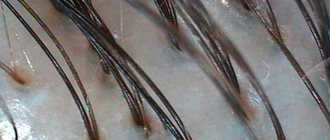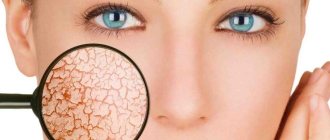Almost all modern women and men are not indifferent to their appearance. Hairstyle is perhaps the main component of the image. Taking care of the thickness of your hair, a person inevitably notices daily losses. How to determine whether the permissible limits are being violated, and what is the normal rate of hair loss?
Why does hair fall out?
Hair falls out every day. This is due to the hair growth cycle. Hair goes through several stages: - Anagen - hair growth phase. During this period, the hair actively grows due to the division of root cells, elongates and thickens. This stage lasts from 2 to 5 years and contains 80-85% of the hair on the head;
- Catagen is the next phase, which occurs when root cells stop actively dividing, hair growth slows down, then stops and atrophy of the hair follicle occurs. The follicle decreases in size, “dries out,” and gradually moves to the surface of the scalp to fall out. This phase lasts 2-4 weeks. In the catagen stage, no more than 2% of the hair is on the head at any one time;
— Telogen is the resting period of the follicle, which lasts about 3 months. At this stage, the hair is practically not attached to the scalp and can fall out at any time (especially with physical impact), or will be pushed out by new growing hair. There are 15-20% of such hair on the head.
— Early anagen is the process of birth of new hair.
It is during the telogen period that hair can leave our head and hair loss is normal if it does not exceed 50-100 hairs per day.
Types of Hair Loss
- Androgenetic alopecia (more common in men). We described its mechanisms above.
- Diffuse alopecia (more common in women). It develops as a result of the body’s reaction to the influence of some factor - malfunctions of the body, taking medications, etc.
- Psychosomatic or nervous alopecia. Develops as a result of stress, depression and other neuropsychiatric disorders. In this case, a person may need the help of a neurologist, endocrinologist and psychotherapist.
- Alopecia areata. It often ends in complete baldness, and in some cases, loss of absolutely all hair on the body. A poorly studied type of alopecia, the causes of which are unknown to doctors. At the moment, alopecia areata is classified as an autoimmune disorder.
- Cicatricial or infectious alopecia. It develops as a result of exposure to various infectious diseases on the body.
- Age-related alopecia. This is a natural, gradual process of hair thinning and thinning that occurs with age.
- Seasonal alopecia. Another natural process that causes anxiety in many girls. Most often it manifests itself in the spring as a result of vitamin deficiency and vitamin D deficiency. Within 3 months, hair loss stops and hair resumes its growth.
A simple test for shedding rate
How much hair do you lose? It's very easy to check. Just comb your hair over the sink or white towel at the end of the day and count. Just don’t do this on the day before which you didn’t wash your hair for several days in a row and “accumulated” lost hair on your head.
I would especially like to address pregnant and lactating girls. It is important to know that due to hormonal changes during pregnancy, hair practically stops falling out. But after childbirth or after the end of lactation, everything that was accumulated during the months of pregnancy and lactation falls out. And there is no need to be afraid of this. The situation will normalize in 2-3 months. If this does not happen, this is already a cause for concern and you need to consult a doctor.
I want to see a trichologist
Myths about hair
There is a lot of unreliable information about human hair that you shouldn’t trust too much.
Among the most common myths are:
- Hair remaining on the comb is the first sign of hair loss. In fact, this is a natural process that only requires determining whether the daily hair loss rate has been exceeded.
- The use of drugs and various styling products becomes the main reason for the weakening of the follicles. Modern varnishes, gels, mousses and other styling products do not get inside the curls and follicles, and therefore do not affect the growth of strands and their strength. There is only one important nuance - safety has been confirmed only for high-quality products, but there are companies that add harmful substances to hair cosmetics; it is impossible to predict how they will affect the hairstyle.
- Critical hair loss is typical only for men. Yes, indeed, about 96% of older men experience pathological loss of strands, which is especially noticeable in the central part of the head.
There are fewer women with increasing hair loss, about 79%, and their thinning evenly covers the entire head in most cases. - Hair falls out more intensely if you wash your hair every day. In fact, this is not so, shampoos do not have a weakening effect on the roots of curls, and the mechanical effect contributes to the loss of only those hairs that have already completed their life cycle.
- Hair will be less likely to leave your head if you trim it more often and shorter. Some believe that the longer the strands, the heavier they are and the hair follicle simply cannot withstand their weight. In fact, this is just a myth; hair weighs so little that even the longest strands hold on tightly without provoking reasons.
- Folk remedies will help solve the problem of hair loss without visiting a trichologist. In case of excessive hair loss, bald spots and alopecia, it is necessary to determine the main cause of the defect. Depending on the identified changes, the doctor selects a comprehensive treatment, and the use of various masks and rubbing are only auxiliary, but not the main methods of therapy.
- Diets can cause baldness. This myth is only partially true. A low-protein diet with less than 100 kcal per day has a negative effect on hair strength. Frequent repetition of strict mono-diets with the consumption of only one type of product can also provoke the loss of strands.
- Constantly wearing hats is the cause of baldness. Hats and tight baseball caps only lead to increased hair fragility.
- New curls will never appear in place of hair that has fallen out from the roots. The hair follicle is not damaged during natural loss; after a while it will begin to function again.
- Hair cannot change for the worse from cold and sun rays. This is one of the most common and harmful myths. It is low temperatures in winter and ultraviolet radiation in summer that sometimes become one of the main causes of sudden baldness. Therefore, both in winter and in the warm season, walking without a hat is not recommended at any age.
Is new hair growing?
Another important point to pay attention to is how much new hair is growing on your head? Hair falls out and this is normal if it is replaced by new growing hairs. In each parting 5 cm long, 10-15 short hairs should grow. You can check how things are going for you at home by examining several partings in different places on your head and counting the hairs. And if there are less than 10 of them, then this is an even more serious problem than losing more than 100 hairs per day. Hair can fall out for various temporary reasons (stress, colds, seasonal loss), but if it does not grow, then there will be no one to replace the loss.
What do lost roots say?
Each hair goes through its own individual life cycle, lasting on average about three years. Every month, normally growing curls should add a little more than one centimeter in length.
As soon as the anagen phase comes to its logical conclusion, the hair root weakens and it is pushed out of the bulb.
This is how the natural loss of hair that has completed its life cycle occurs. At the same time, a whitish thickening remains at the end.
The following changes indicate pathological hair loss:
- The fallen hair at the end does not have a white thickening, but simply a dark end.
- Hair falling from the head has the same thickness throughout its entire length. Most often, this indicates increased hair fragility, which may indicate aggressive chemical effects of dyes and curls, fungal and bacterial diseases of the skin.
- A constant and steadily increasing excess of the number of lost curls compared to the norm.
In some cases, people notice that their hair is more durable and does not fall out of their head at all.
This condition is also a pathology and indicates that there is no hair growth, which means that at any point in life the problem of rapid baldness can become acute.
Law of Thick Hair
For your hair to be thick, it must fall within normal limits and grow at least as long as normal. If one or even both of these criteria suffers, you need to take action!
A universal remedy that helps stop hair loss and at the same time stimulate new hair growth are peptide-based serums. They improve local blood circulation, nourish the roots, activate growth and block hormones leading to degeneration of hair follicles. Thus, the main causes of hair loss are neutralized and favorable conditions for growth are created.
If your hair is not falling out much and the hair loss has started recently, then you can begin to solve this problem with the help of serums at home. If after 2 months the situation does not improve, then you need to consult a trichologist.
LEARN MORE ABOUT HAIRFOOD PRODUCTS
The effect of testosterone on hair growth
Androgenetic alopecia is hair loss due to excess of the male sex hormone testosterone. This disorder can occur among both men and women. In the hair follicle, testosterone, under the action of 5-alpha reductase, is converted into dihydrotestosterone, which affects the size of the hair, making it thinner. In men and women, androgenetic alopecia is caused by the same factor - excessive production of testosterone and increased sensitivity of the hair follicles to it. Under the influence of the male sex hormone, hair follicles gradually become smaller and hair falls out, leading to the characteristic bald patches.
Androgenetic alopecia is the most common cause of hair loss in men, but can also occur in women over 40 years of age. The process develops over the years, gradually affecting more and more follicles and becoming more pronounced with age.
The following roles play a role in the pathogenesis of androgenetic alopecia:
- increased levels of male sex hormone;
- high sensitivity of follicles to androgens;
- increased density of androgen receptors;
- increased level of 5-alpha reductase type 2.
Determining the level of total testosterone will allow you to assess the risks of developing androgenetic alopecia and prescribe appropriate measures to correct them.
Features of men's hair
Men's hair is different from women's. Men's hair is harder, denser and more prone to falling out. Hair loss occurs gradually; in most cases, areas are formed where the thickness of the hair decreases, it becomes weaker, strong hair is replaced by vellus hair and gradually falls out. These patches of lost hair grow and merge. The most likely location of areas without hair is the forehead and parietal area. Over time, they can form a single lesion without hair.
Necessary tests
An accurate diagnosis in cases of male hair loss is of great importance. In case of loss, consultations with specialized specialists - a gastroenterologist, endocrinologist and others - may be required. On the first visit, the trichologist will:
- examination of the scalp and hair with a special apparatus with the possibility of multiple image magnification;
- collection of complaints;
- determining the reason why hair began to fall out;
- prescription of treatment.
Blood tests may be required - general, hormonal levels and others, which will reliably show the impact of health on the condition of the hair. The exact list of necessary studies is determined individually.
Thyroid diseases
The formation of receding hairline, diffuse, as well as focal and total forms of hair loss can be associated with incorrect functioning of the thyroid gland. Alopecia is observed both in hypothyroidism (insufficient production of thyroid hormones) and in hyperthyroidism (excessive activity of the organ). It is necessary to contact an endocrinologist. These conditions are corrected with medications. Other gland diseases can also cause baldness. With proper treatment by an endocrinologist together with a trichologist, not only the hairline is restored, but also the hormonal levels, which affect all spheres of the body’s vital functions.










